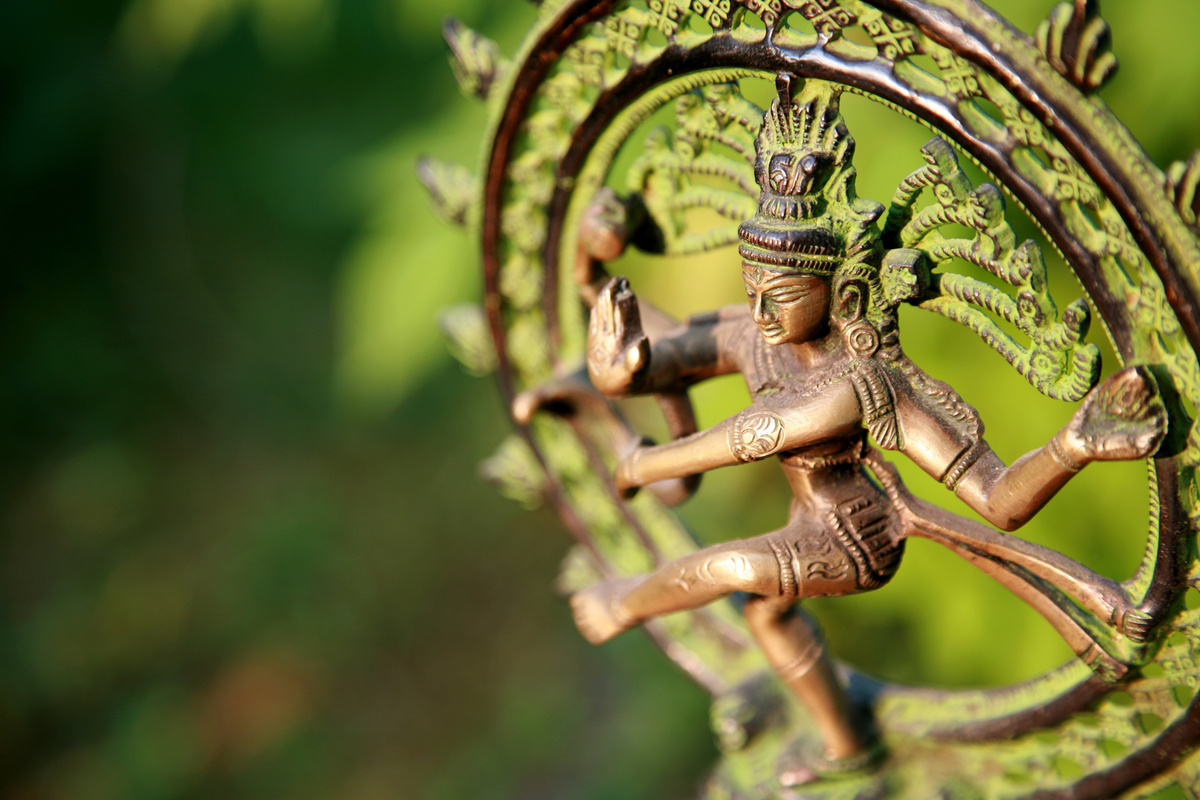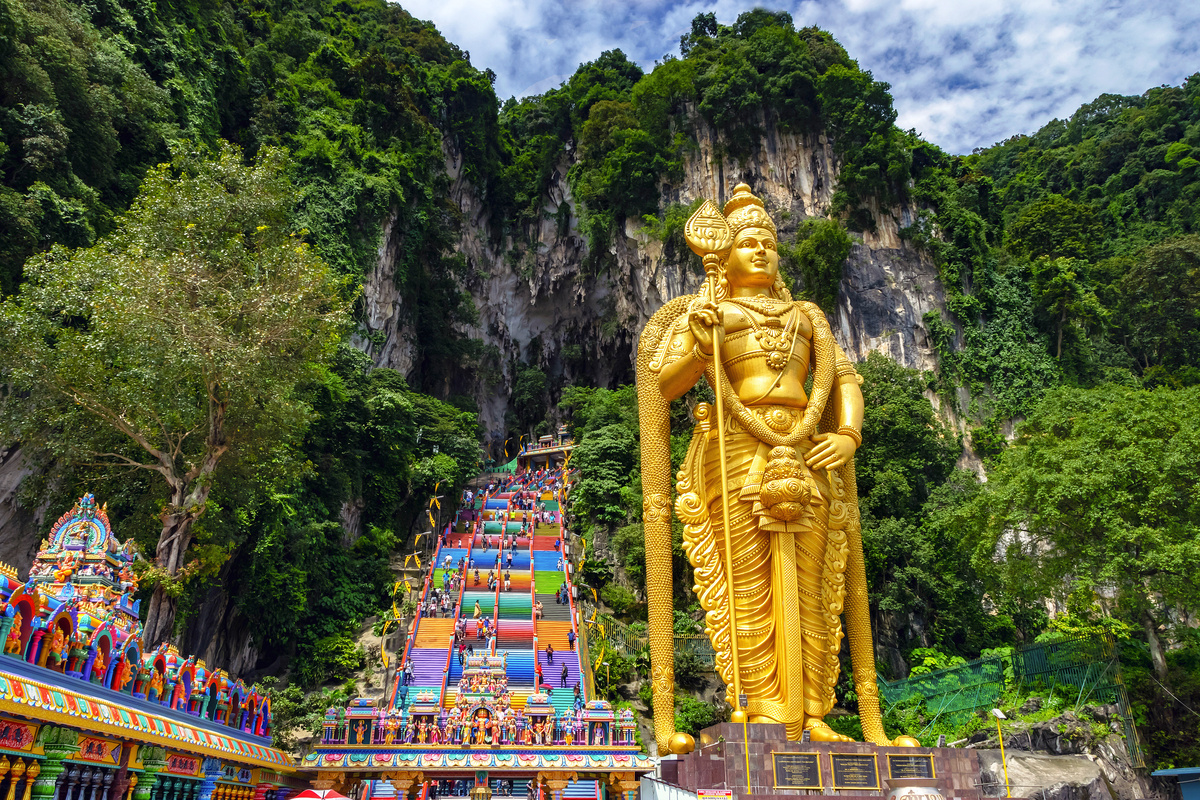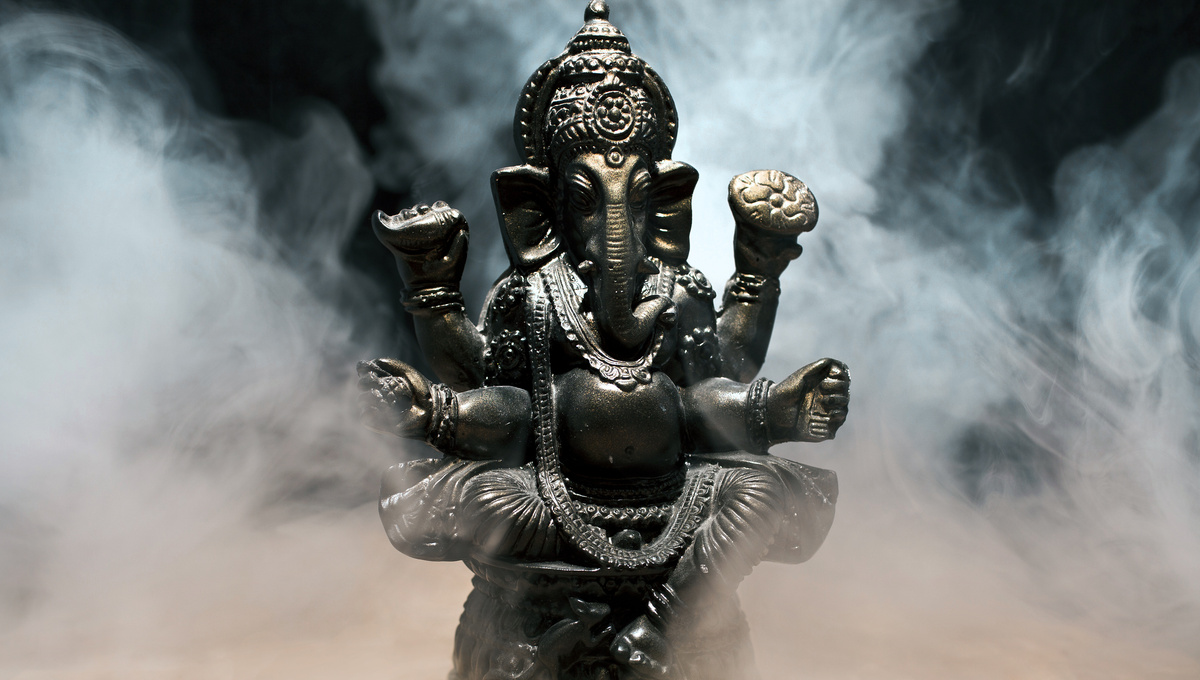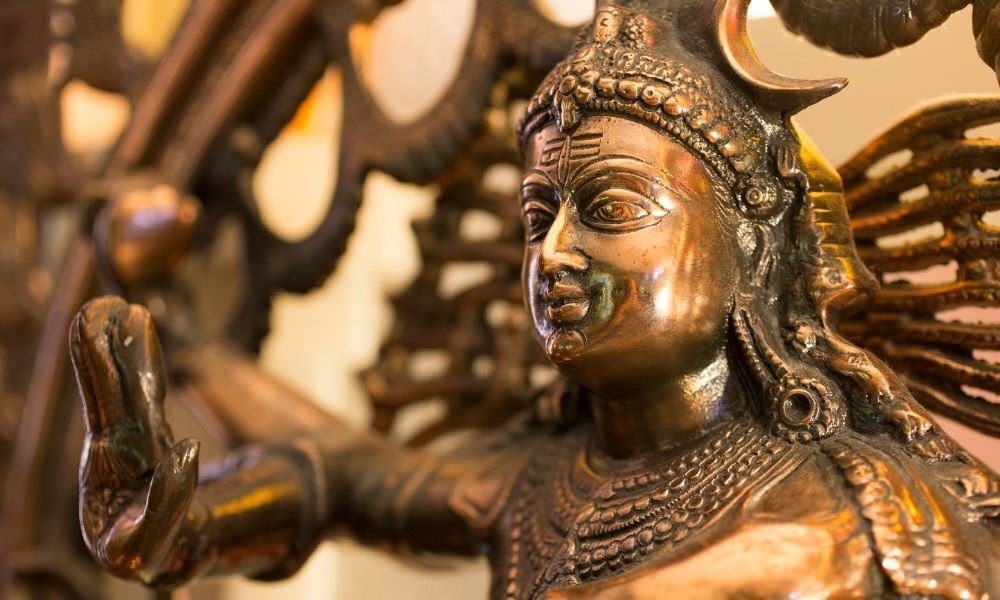Table of contents
Learn more about the Indian gods!

Indian Gods are deities belonging to the mythology and beliefs of Hinduism, one of the main religions of India. The name of the deities and their epithets vary, according to the traditions in which they are embedded.
In general, the concept of gods in India also varies, from the perspective of a personal god, as in the Yoga school, to a group of 33 deities and hundreds of deities, according to Puranic Hinduism.
Since Hinduism has several branches and schools, it is difficult to know for sure the total number of Indian gods, and their number may reach into the thousands.
In this article, we will present the origins of these divine beings, starting with a walk through their history and presenting their roots in the Hindu religion, Hinduism. Then, we will describe their main deities, such as Agni, Parvati, Shiva, Indra, Surya, Brahma, Vishnu and the beloved Ganesha, to finally talk about curiosities of this fascinating mythology. Check it out!
Origin of Indian Gods

The origin of the Indian gods is recorded in various sacred scriptures. They have evolved through the histories, from their records dating back to the second millennium before the Common Era, and extending up to the medieval period.
To understand it, it is necessary to understand the religion that contains them, Hinduism, including its beliefs, practices and festivals. Check it out below!
Hinduism
Hinduism is the third largest religion in the world. It is believed to have originated around 2300 B.C. in the Indus Valley, located in the region of present-day Pakistan. Unlike other major religions, Hinduism does not have a founder. Instead, this religion encompasses a mixture of many faiths.
For this reason, Hinduism is often considered a lifestyle or a collection of religions rather than a single religion. Within each of these versions, there are specific belief systems, practices and sacred texts.
In the theistic version of Hinduism, there is belief in several gods, many of them linked to natural phenomena and different aspects related to humanity.
Beliefs
Hindu beliefs vary from tradition to tradition, however, some basic beliefs include:
- Henotheism: worship of a divine essence, known as Brahman, without denying the existence of other divinities;
- Belief that there are different paths that lead to their god;
- Belief in the doctrines of 'samsara', the ceaseless cycle of life, death and reincarnation;
- Recognition of Karma, the universal law of cause and effect;
- Recognition of the 'atman', the belief in the existence of the soul;
- Acceptance that people's actions and thoughts in this life will determine what will happen in this and their future lives;
- Attempt to attain dhrama, a code that stresses the importance of living with good conduct and morality;
- Reverences of various living creatures, such as the cow, so many Hindus are vegetarians.
Practices
Hindu practices are based on 5 basic principles. They are:
1) The existence of the Godhead;
2) Belief that all humans are Divine;
3) Unity of Existence;
4) Religious Harmony;
5) Knowledge of the 3 Gs: Ganges (the sacred river), Gita (the sacred writing of the Bhagavad-Gita) and Gatri (a sacred mantra of the Rig Veda and a poem in the same specific metric).
Based on these principles, Hindu rituals include puja (reverence), recitations of mantras, japa, meditation (known as dhyāna), in addition to occasional pilgrimages, annual festivals, and family-based rites of passage.
Celebrations
There are many Hindu celebrations including holidays, festivals and holy days, some of the main ones are:
- Diwali, the festival of lights and new beginnings;
- Navaratri, celebration to honor fertility and harvest;
- Holi, the spring festival, also known as the festival of love and colors;
- Krishna Janmashtami, celebration of the birthday of Krishna, the eighth Avatar of Vishnu;
- Raksha Bandhan, celebration of the pitches between sister and brother;
- Maha Shivaratri, known as the Great Festival of Shiva.
Principal names of Indian gods

Hinduism has a wide range of deities. The term for deity even varies from tradition to tradition and can include Deva, Devi, Ishvara, Ishvari, Bhagavān, and Bhagavati. Read on to learn more about deities and the gods such as Ganesha, Vishnu, and Kali!
Ganesha
Ganesha is the elephant-headed god. Son of Shiva and Parvati, he is the lord of success, abundance, wealth and knowledge. He is one of the most known and worshipped divinities of Hinduism, revered in all its branches. Therefore, he is considered one of the most important gods.
This god is usually depicted riding a mouse, whose assistance is essential for removing career obstacles and achieving success. His main festival is Ganesh Chaturthi, which occurs on the fourth day of the Hindu month Bhadrapad.
Rama
Rama is a human avatar of Vishnu. He is the god of truth and virtue, considered the chief personification of humanity in its mental, spiritual and physical aspects.
It is believed that Rama was a historical character who actually existed, the main record of which is found in the Sanskrit epic called Ramayana, written in the 5th century B.C. Rama is celebrated in the Hindu festival of light, known as Diwali.
Shiva
Shiva is the god of death and dissolution. Considered the master of dance and regeneration, he acts by destroying worlds so that they may be recreated by the god Brahma. He has roots prior to the Vedic period, so that much of what is known about him today is a combination of various deities, such as the storm god Rudra.
He is considered one of the main deities that make up the Hindu Trinity and is known by many different names, such as Pashupati, Vishwanath, Mahadeva, Bhole Nath and Nataraja. Shiva is generally seen as a human figure with blue skin, but can be commonly represented by a phallic symbol, called Shiva's Lingam.
Durga
Durga is the maternal aspect of the goddess Devi and represents the fiery powers of the gods. She acts as protector of those who act rightly and destroyer of evil. In addition, she is usually depicted riding a lion and carrying a weapon in each of her multiple arms.
Her cult is widespread, as she is associated with protection, motherhood and even wars. She fights evil and all dark forces that can threaten peace, prosperity and dharma.
Krishna
Krishna is the god of love, tenderness, protection and compassion. Considered one of the most beloved deities by Hindus, Krishna is represented with his flute, used to activate his powers of attraction and seduction.
Being the central figure of the Bhagavad Gita and the eighth avatar of the god Vishnu, he is widely worshipped and is part of the Hindu Trinity. His main festival is Krishna Janmashtami, which occurs in late August or early September, according to the Gregorian calendar.
Saraswati
Saraswati is the Hindu goddess of knowledge, music, art, speech, wisdom and learning. She is part of the tridevi, a trinity of deities, which include the goddesses Lakshmi and Parvati. This set of goddesses are equivalent to the trimurti, another trinity consisting of Brahma, Vishnu and Shiva, to create, maintain and regenerate the universe respectively.
Sarawasti also represents the free flow of consciousness. She is the daughter of Shiva and Durga, the mother of the Vedas. Her sacred chants are called Saraswati Vandana, which tell how this goddess granted the powers of speech and wisdom to humans.
Brahma
Brahma is known as the creator god. He is one of the principal deities of Hinduism and is a member of the Trimurti, the trinity of gods, along with Vishnu and Shiva, who represent the creator, sustainer and destroyer of worlds respectively. Often these three gods reveal themselves in the form of avatars, as a god or goddess.
As the supreme being, gods and devas represent one or more aspects of Brahma. Brahma is the god who has four faces and each face corresponds to one of the four Vedas, the oldest sacred scriptures of Hinduism.
Lakshmi
Lakshmi is the goddess of luck, fortune, power, beauty and prosperity. She is also associated with the concept of Maya, which can refer to illusion and is represented holding a lotus flower. Her name means "she who guides to her goal" and she is one of the three deities that make up the trivedi, along with Parvati and Saraswati.
Goddess Lakshmi is worshipped as an aspect of the Mother Goddess and embodies in herself the shakti, the divine energy, and is also the wife of the god Vishnu. Together with Vishnu, Lakshmi creates, protects and transforms the universe. She has eight prominent manifestations, known as the Ashtalakshmi, which symbolize the eight sources of wealth. The Diwali and Kojagiri Purnima festivals are practiced in her honour.
Vishnu
Vishnu is the god of love and peace. He represents the principles of order, truth and integrity, and his chief duties are to preserve and sustain life. Vishnu is consort of Lakshmi, the goddess of prosperity and domesticity, and together with Shiva Brahma forms Trimurti, the divine holy trinity of Hindus.
The followers of Vishnu are called Vaishnavas in Hinduism and they hold the belief that Vishnu will arise in times of chaos and disorder to restore order and peace on planet earth.
In this way, Vishnu is depicted in both benevolent and frightening ways. In his benevolent aspect, he rests on the spirals of the serpent that represents time, Adishesha, and floats in the primordial ocean of milk, called Kshira Sagara, along with his consort Lakshmi.
Hanuman
In Hinduism, Hanuman is the monkey-headed god. Worshipped as a symbol of strength, perseverance, service and devotion, he is the primate god who assisted Rama in the battle against the forces of evil, the description of which is present in the Indian epic poem called 'Ramayana'.
When one is going through any problem, Hindus usually chant chants calling on Hanuman's name or sing his hymn called 'Hanuman Chalisa' so that they receive intervention from this god. The public temples of Hanuman are the most common throughout India. Moreover, he is the son of the god of wind, Vayu.
Nataraja
Nataraja is the name of the Indian god Shiva in the form of a cosmic dancer. He is the lord of the dramatic arts, whose sacred dance is called Tandavam or Nadanta, depending on the context in which it is practiced.
Both the pose and references to this form of the god Shiva is found in various sacred texts and the form of his sculpture is commonly used to symbolize India. Representations of Nataraja are found in caves and at various historical sites in Southeast and Central Asia.
Indra
Indra is the king of the Indian gods, also ruling over paradise. He is associated with lightning, thunder, storms, rain, river flows and war, possessing similar attributes to other gods of other mythologies, such as Jupiter and Thor.
He is one of the most quoted deities in the Rigveda and is celebrated for his powers to fight and defeat the evil called Vritra, which prevents people from being happy and prosperous. By defeating Vritra, Indra brings rains and rays of sunshine, as an ally and friend of mankind.
Harihara
The Indian god Harihara is a divine fusion between the gods Vishnu (Hari) and Shiva (Hara), which is also known as Shankaranarayana (Shankara is Shiva and Narayana is Vishnu). This divine characterization is worshipped with a form of the Divine God.
Often, Harihara is used as a philosophical concept that represents different aspects of the Ultimate Reality known as Brahman, which resumes the concept of unity important to Hindu beliefs. His image is represented as half Vishnu and half Shiva.
Kumar Kartikeya
Kumar Kartikeya, or simply Lord Kartikeya, is the Hindu god son of Shiva and Parvati, revered mainly in southern India. This god also has various names, such as Murugan, Shanmukha, Guha, Saravana and many others.
He is the god of war and victory, worshipped also due to his fearless and intelligent nature and for being a personification of perfection. According to the legend, Shiva and Parvati showed more love for the god Ganesha and, therefore, Kartikeya decided to move to the southern mountains, when he started to be worshipped more in that religion.
Shakti
Shakti is the primordial cosmic energy. Its name means, in Sanskrit, energy, capacity, ability, power, strength and effort. It represents the dynamic nature of the forces that circulate through the universe. In some strands of Hinduism, Shakti is the personification of the Creator, known as Adi Shakti, the inconceivable primordial energy.
Thus, Shakti manifests in all universes through matter, but her true form is unknown, as it is beyond human comprehension. Therefore, she is the one without beginning and end, Anaadi, as well as the eternal one, Nitya.
Parvati
Parvarti is the Indian goddess of fertility, beauty, bravery, divine strength, harmony, devotion, marriage, love, power and children. She is the gentle and nurturing form of the goddess Mahadevi, one of the main deities of Shaktism.
She is a mother goddess who forms, with Lakshmi and Saraswati, the divine triple known as Tridevi. Parvati is the consort of god Shiva, besides being the reincarnation of Sati, wife of shiva who sacrificed herself during a yajna(sacrifice through fire).
Moreover, she is the daughter of the mountain king Himavan and queen Mena. Her sons are Ganesha, Kartikeya and Ashokasundari.
Kali
Kali is the goddess of death. This attribute gives her the title of black goddess, as she is best known. She appears as a powerful four-armed woman with black or dark blue skin, drenched in blood and with her tongue sticking out.
In addition, she appears on top of her husband Shiva, who lies calmly under her feet. Kali also represents the unceasing march of time towards the end of days.
Agni
According to Hinduism, Agni is the Indian god of fire, which is also the meaning of his name in Sanskrit. He is the guardian deity of the southeastern direction and therefore the fire element is typically found in this direction in Hindu temples.
Along with space, water, air and earth, Agni is one of the impermanent elements. When combined, they represent the experience of matter. Along with Indra and Soma, Agni is one of the most invoked gods in Vedic literature.
Thus, he is represented on three levels: on earth, Agni is the fire; in the atmosphere, Agni is the lightning; finally, in the sky, Agni is the sun. His name appears extensively in Buddhist scriptures.
Surya
Surya is the Indian sun god. He is usually depicted driving a chariot pulled by seven horses, which represent the seven visible colors of light and the seven days of the week. He has a chakra called the Dharmachakra and is the lord of the constellation Leo.
In medieval Hinduism, Surya is also an epithet of majority gods of the Hindu pantheon like Shiva, Brahma and Vishnu. His holy day is Sunday in the Hindu calendar and his festivals are Mankar Sankranti, Samba Dashami and Kumbh Mela.
Further information about the gods of India

Now that you have read about the Indian gods, you will find more information about them in the following sections. Have you ever wondered if the gods vary, over the ages, or why they have gender or many arms? Find out the answers to these questions below!
Deities of Vedic era and medieval era
Indian deities vary according to era. In the Vedic era, Devas and Devis represented the forces of nature and some moral value, symbolizing expert knowledge, creative energy and magical powers.
Among the Vedic gods, we find Adityas, Varuna, Mitra, Ushas (the dawn), Prithvi (the earth), Aditi (cosmic moral order), Saraswati (the river and knowledge), besides Indra, Agni, Soma, Savitr, Vishnu, Rudra, Prajapi. Moreover, some Vedic gods evolved with time - Prajapi, for example, became Brahma.
In the medieval period, the Puranas were the main source of information about the gods and cited deities such as Vishnu and Shiva. In this period, Hindu deities lived and ruled over the heavenly bodies, taking on the human body as their temples.
Hindu gods are considered to be of a double gender
In some versions of Hinduism, the gods are considered to be of double gender. In Hinduism, in fact, there are different approaches to establishing relationships between the concepts of gender and the divine.
The divine concept, Brahman, for example, has no gender, and many other gods are considered androgynous, both male and female. The Shakti tradition, on the other hand, considers god to be female. But in the case of medieval Indian mythology, each male deva has a female consort, usually a devi.
Some Hindu gods are also represented as female or male, depending on their incarnation, and some of them are even male and female at the same time, as is the case of Ardhanarishvara, resulting from the fusion of the gods Shiva and Parvati.
Why are there so many Hindu gods?
There are many Hindu gods, as the notion of dharma recognizes the infinite nature of the divine. In addition, the Hindu religion is generally considered polytheistic. Like all polytheistic religion, there is the belief and worship of more than one deity.
In this way, each deity represents a specific attribute of the Supreme Absolute, known as Brahman.
Therefore, there are beliefs that each deity is actually manifestations of the same divine spirit. It is also possible to speak of gods that are recognized in animals, plants and stars, or even that are represented in the family or in specific regions of India.
Why do Indian gods have so many arms?
Indian gods have many arms to visually represent their supreme powers and their superiority over mankind.
The many arms become visible, when they are battling with the orbs of the cosmos. The artists represent the gods with many arms in their images, to express also the supreme nature of the gods, their immense power and the strength to perform several tasks and acts at the same time.
Generally, gods also have an object in each hand, symbolizing the multiple qualities of that particular deity. Even when gods have empty hands, the position of their hands also indicates some attribute of that deity. For example, if the fingers point downward, it means that this god is associated with charity.
Hindus worship many gods and goddesses!

As we have shown throughout the article, Hindus worship many gods and goddesses. This is actually because many strands of Hinduism are polytheistic in nature.
Besides, Indian people speak many languages, with cultural particularities that make them understand this single divine essence in different ways. Despite presenting distinct forms, names and attributes, Indian gods are, in fact, manifestations and associations of Brahman, who represents the spirit of creation.
Especially when considering that Brahman has multiple attributions and powers, it is only natural that this spark of energy manifests itself differently. This divine multiplicity makes the Hindu religion one of the most beautiful, rich and diverse in the world.
Thus, based on this religion, it is known that God does not dwell in the sky far away from humanity: he resides in every element of nature and within all beings on Earth. Therefore, Hindus worship every aspect of this energy, celebrating all its colors and the multiplicity of this divine energy.

